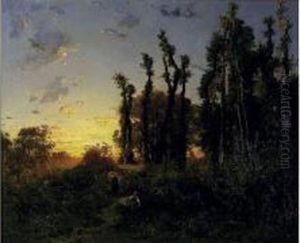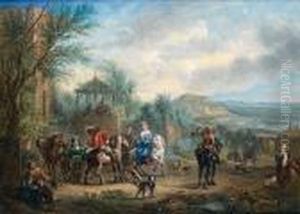Alexandre Paul Jos. Veron Bellecourt Paintings
Alexandre Paul Joseph Veron-Bellecourt, born in 1823 and deceased in 1900, was a French artist known for his contributions to 19th-century European painting. While not as widely recognized as some of his contemporaries, Veron-Bellecourt carved a niche for himself with his distinctive style and subject matter.
Veron-Bellecourt was trained in the traditional academic style of painting, which was dominant in French art schools during the early 19th century. This education provided him with a solid foundation in the techniques of drawing and painting, as well as a thorough understanding of classical and neoclassical principles of art. He studied at the École des Beaux-Arts in Paris, which was the preeminent art school in France at the time. Under the tutelage of prominent instructors, he honed his craft and developed a penchant for genre scenes, landscapes, and portraits.
Although Veron-Bellecourt's works adhered to academic standards in terms of composition and technique, he also exhibited a sensitivity to the changing artistic currents of his time. The latter half of the 19th century was a period of great transformation in the arts, with movements such as Realism and Impressionism challenging traditional aesthetics. Veron-Bellecourt's paintings often reflected a realist impulse, showcasing everyday life and the natural world with a degree of honesty that was at odds with the more romanticized or idealized images preferred by some of his academic peers.
Throughout his career, Veron-Bellecourt exhibited his works in various salons and galleries, garnering respect and recognition among art collectors and critics. His paintings can be found in regional French museums and private collections, and although he may not have achieved the fame of artists like Édouard Manet or Claude Monet, his contributions to French art during a period of great change are nonetheless appreciated by art historians and enthusiasts.
Veron-Bellecourt's legacy is that of a skilled painter who bridged the gap between traditional academic art and the newer, more progressive movements that emerged during his lifetime. He remained committed to his artistic vision, creating works that have since been recognized for their elegance and historical value. Alexandre Paul Joseph Veron-Bellecourt passed away in 1900, leaving behind a body of work that continues to be studied and admired for its place in the development of 19th-century French painting.










